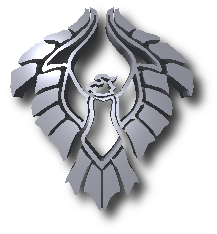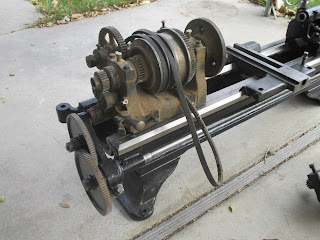You will notice that I've already put the tailstock back together, and I've taken apart the cross-slide and compound. In fact, the compound assembly isn't even in the picture because it's being warmed up in the house in preparation for paint. The cross-slide went back in after taking the picture.
It is true that there is no associated countershaft - the previous owner to the last owner lost it, along with the change gears. I do need change gears, but I should be able to work without the countershaft by using a variable-speed DC motor.
I found the serial number in the usual place (tailstock end of the bed) :
The serial number found on the lathe bed is 47049A. The "A" is supposed to indicate a gear change box, but there isn't one, and never was - the screw holes are not included for the gear change box on the bed itself. This is simply because the lathe is tool old - the "A", "B", and "C" designations came a year or two later. The gentleman I bought it from stated he got it from his Father-in-Law, and his Father-in-Law picked it up from a Dental company for fairly cheap. The Father-in-Law also used it to turn wood (actually, to my happiness - the wood kept oil in places it needed to be, keeping it in fairly decent shape). That is all I knew, so I had to do a little more research.
I started to grab some details. Grizzly (manufacturer of some small lathes) purchased South Bend Tool Company a few years back, and offers a service where you can obtain the "serial card" for old South Bend Lathes in PDF format (just $25). This card typically offers more details and specifications for the lathe, including what options and accessories were purchased with it. However, if yours is as old as mine is, be aware you might not get anything but a "ledger line". Here's what Grizzly was able to provide for that $25 (and yes, I believe it was worth it as it gave a model, a sales date, and the company it was sold to).
Mine didn't wander terribly far from home. It was purchased by the Salt Lake Hardware Company on January 24, 1930. It is actually considered a 9x3 (9" swing, 3' bed), so the original dimensions from South Bend are full bed length, not between centers. The model is 22YB (which is also called a "Junior"). In 1948, South Bend copied those ledgers onto Serial Cards, but didn't add any information (obviously, 18 years later, they won't be able to add details). Incidentally, Grizzly was kind enough to not just send the ledger row in PDF, they also sent a slightly more legible serial card in PDF along with it :
Model 22-YB information :
From the catalog, we read "The 9-inch Junior New Model Precision Lathe ... is driven from an overhead countershaft which is bolted to the ceiling and connected by belt to the mineshaft. We recommend the Countershaft Drive Lathe for the shop that is already equipped with lineshafting from which other machines are being operated. The Junior lathe in the 3-foot bed length is the most popular size.
"Handles Wide Variety of Work. The New Model 9-inch Junior Back-Geard, Screw Cutting Precision Lathe machines all kinds of metals and has the power and accuracy required for fine precision work. It has automatic longitudinal feed and a wide range of spindle speeds.
"Cutting Screw Threads. An index plate is attached to each 9-inch Junior Lathe and shows the correct change gears to use to cut all standard screw threads from 4 to 40 per inch, right or left, including 11 1/2" pipe thread, as follows : 4, 5, 6, 7, 8, 9, 10, 11, 11 1/2, 12, 13, 14, 16, 18, 20, 22, 24, 26, 28, 30, 32, 36, and 40.
"FEATURES OF LATHE
- Back-Gears headstock gives six spindle speeds.
- Hollow spindle made of special alloy steel
- Phosphor bronze bearings for spindle.
- Graduated compound rest swivels to any angle.
- Precision lead screw for cutting accurate threads.
- Micrometer collar on cross feed and compound rest screws.
- Tailstock set-over for turning tapers.
- Quick-acting spring latch reverses carriage travel.
- Automatic longitudinal power feed to carriage.
- Graduated tailstock spindle.
- Spindle cone pulley balanced for operation at high speeds.
| Original Price | : | $169 |
| Swing | : | 9 1/4" |
| Bed Length | : | 36" |
| Between Centers | : | 16 3/8" |
| Hole Through Spindle | : | 3/4" |
| Swing Over Carriage | : | 6 3/8" |
| Width Cone Pulley Steps | : | 1 1/4" |
| Power Required | : | 0.25HP |
| Weight Crated | : | 375 lbs |
| Countershaft Speed | : | 255 RPM |
| Spindle Speeds | : | 39, 64, 110, 208, 348, and 596 RPM |
| Width of Cone Pulley Belt | : | 1 1/4" |
| Acme Thread Lead Screw | : | 3/4" 8 pitch |
| Size of Lathe Centers | : | No. 2 Morse Taper (MT2) |
| Screw Cutting Range | : | 4 to 40 per inch |
| Draw-in Collet Chuck Capacity | : | 1/64" to 1/2" |
| Cross Slide Travel | : | 7 1/6" |
| Size of Tool Shank for Tool Post | : | 11/32" by 13/16" |
| Double Friction Countershaft Pulleys | : | 6 7/8" x 2 3/16" |
| Back Gear Ratio | : | 5.4 to 1 |
More About This One :
This was (apparently) a custom build by South Bend around early 1930. It partially had the original black "japanning" finish on it - the bed did not because the previous owner had removed and repainted the bed - I'll finish the refinish that way to get it to match, though I don't want to. It came from previous owners with an 8" Cushman chuck (Ref No. 6234A), tailstock, apron (for power feed), cross feed, tool post, and tool holder, but no counter shaft. The headstock has an opening around the threaded area that is 0.926" wide, which equates to about a morse taper 3 (MT3). The headstock threading for the chuck is 0.775" long (not even an inch), and I count approximately 5.5 to 6 threads, which is approximately 8 TPI, with a 1 1/2" diameter of the spindle. The tailstock has an opening about 0.694", which equates to a Morse Taper 2 (MT2).
Here's my shopping list :
- Counter shaft (or a DC, variable motor, since my southbound has a pulley ready for both a v-belt and a flat belt).
- A milling attachment Base (South Bend part number pt825nk2).
- Milling attachment Saddle (South Bend part number as826nk2)
- New tailstock drill chuck
- New tailstock live center
- Tooling
- Reversed jaws for the chuck.
Though it's often considered bad idea to turn wood on a metal lathe, I was actually very happy that the previous owners Father-in-Law turned wood on it. The lathe parts were coated in a soft wood-oil combination, preventing rust in all of the wrong places.
I have already dismantled the Cushman 8" chuck (not reversible jaws), cleaned the old metal chips out, greased it with a nice Molybdenum grease, and re-assembled it. Seems nice and smooth.
The tailstock handle was missing the pin that held it to the actual tailstock ram screw, so I shot to HomeDepot and grabbed a 1/8" steel rod, took it home, cut two inches off, and chucked it into the drill. Using a file, I "turned" it down to the size required. That let me throw the tailstock together :
Additionally, I've cleaned up the apron, repainted, and rebuilt. There is one thing left to to with that - replace the oil cup on it for the hand wheel.
Next up is to finish the cross slide, compound, and tool posts, put them back together, and to get them installed.
After that, it's time to check the headstock and rebuild it. I know they offer kits on eBay for rebuilding this, but it's so old, this one doesn't have any felt seals for the bed. It's going to be a matter of keeping it clean while working on it.













